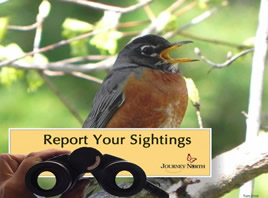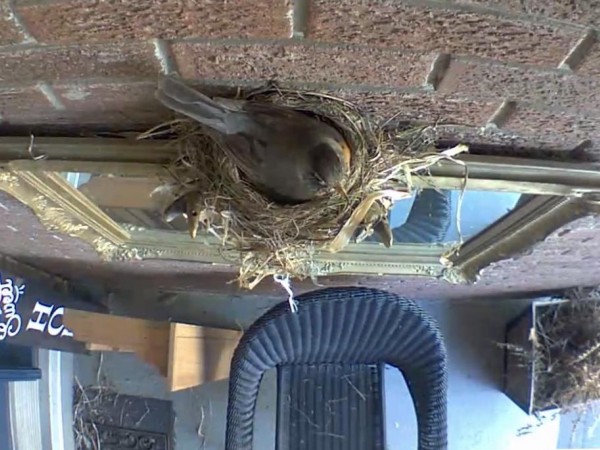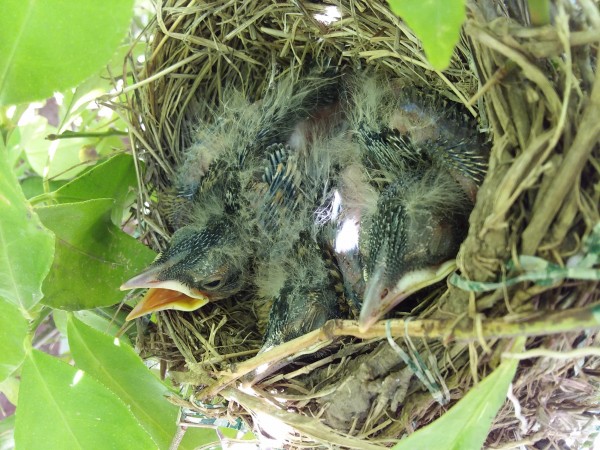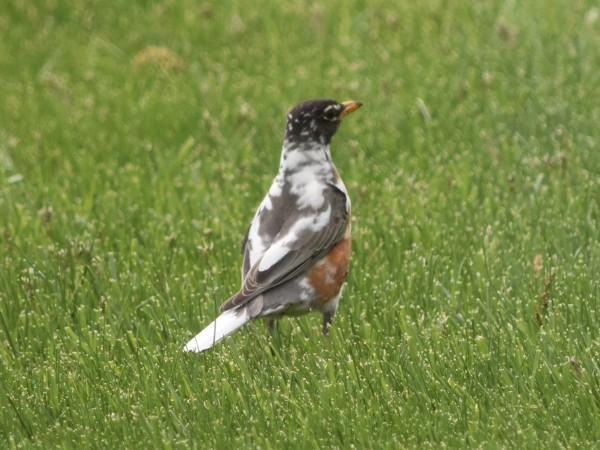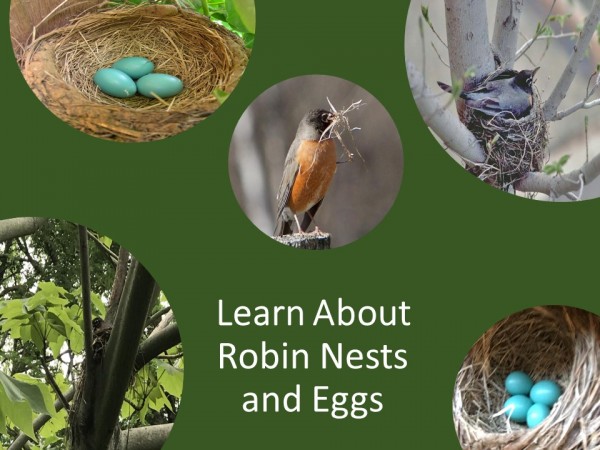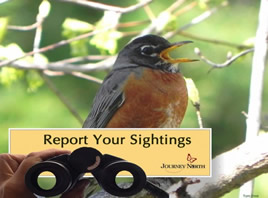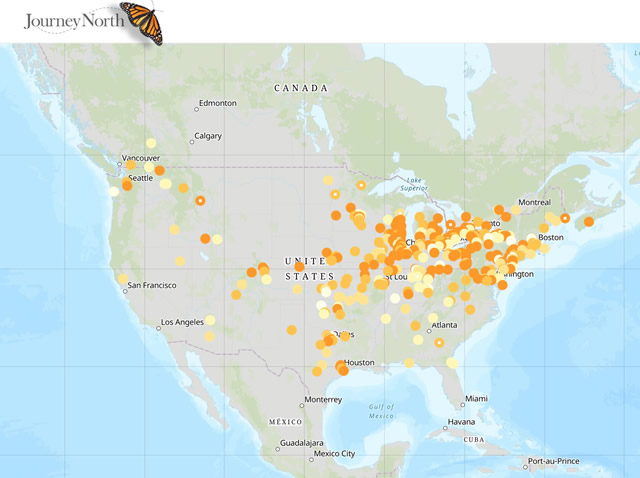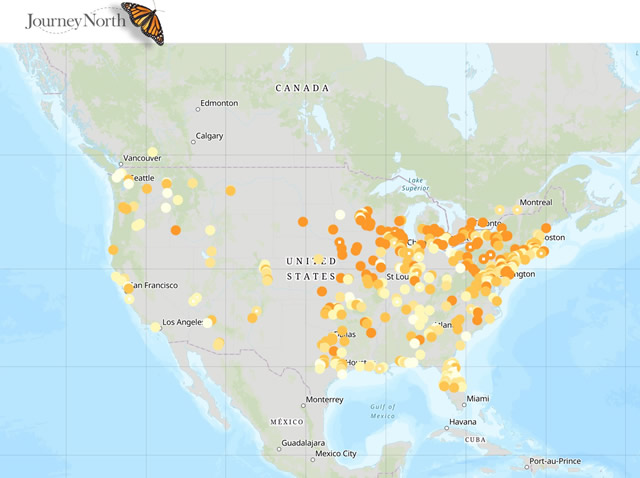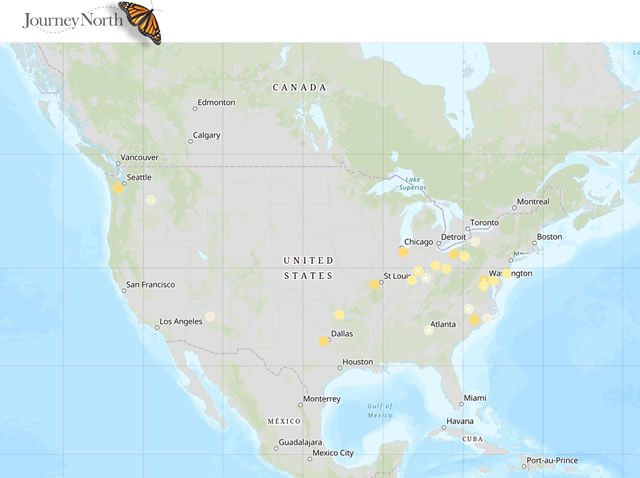Mouths to Feed
Diligent Parents
As Journey North citizen scientists can attest, robins take their parental duties seriously. Male and female robins are responsible for certain jobs as they raise babies. The female builds the nest, lays the eggs, and incubates them. Once the babies hatch, both parents get busy feeding them. When the babies fledge (leave the nest), both parents continue to follow them and feed them. After a few days, the female builds a new nest and lays new eggs. While she incubates the new brood, the male continues taking care of the older babies. By the time the new eggs hatch, the older babies are ready to be on their own and the male is able to help feed the new babies.
From Portland, OR: Dan spotted a female robin and said, “she spent the end of last week constructing the nest. Then we didn't see her for several days. Today she is back and it appears that she's beginning to lay her eggs." (04/28/2020)
From Newmarket, ON: Julie shared, “Robins nest with 2 eggs observed on my front porch. Motion camera indicates female has begun incubation as she has been with the nest through the night.” (05/08/2020)
The Next Generation
Baby robins and fledglings are being reported throughout the United States as spring brings new life.
From Siloam Springs, AR: Barbara shared, "I first peeked in the nest on April 15th, and saw three beautiful, perfect eggs. The little ones hatched out on Tuesday evening, April 28, 2020, minutes before a huge thunderstorm. Luckily, it was a fast-moving storm, but it was fierce. The nest is built like a small fortress, it held tight to the tree, while Mama protected the babies with all her might.” (04/30/2020)
From Oconomowoc, WI: Jamie said, “Picture of mama Robin's babies. I think there’s a 4th one in there waiting to hatch.” (05/01/2020)
From Randolph, NJ: Teresa spotted a, "nest on our front door wreath. Three babies and Mom and Dad feeding them tirelessly." (05/02/2020)
On the Menu
Earthworms – a favorite springtime meal for robins – are being heavily foraged as robins look for high protein food sources to feed their offspring. Journey North citizen scientists are noting more earthworms in their gardens.
From Ansonia, CT: Patty said, “cleaning out our rock garden today and saw our first earthworm of the year. Nice feeling, spring is here!” (04/28/2020)
From Meaford, ON: Barbara L. noted, "Earthworms spotted while digging in my flower gardens." (04/28/2020)
Another Leucistic Sighting
Leucism is a genetic condition which prevents pigments from reaching some or all of a bird's feathers. Leucistic robins tend to have white splotches on their feathers, but the eyes and skin remain their normal color.
From Pekin, IL: M. saw a, “leucistic Robin in our backyard late afternoon. We've had a leucistic in our area the last few years. This one appears to be new as it has a white tail and the former did not.” (05/04/2020)
Two Weeks Left to Report Robins
Only two more weeks to report your Robin sightings (first seen, wave seen, first heard singing, nesting behavior, other observations). Robin news updates end on May 26.
Keep reporting your other sightings with Journey North. Are you seeing hummingbirds, monarchs, or songbirds such as orioles? You can participate in these and a number of other Journey North projects throughout the rest of spring and early summer. Your reports provide valuable data.
I Am Journey North
You still have time to submit your “I am Journey North” photos – this project will run until May 31st. Share what you love about Journey North and the migratory species and habitat you help by submitting data, following news updates and/or planting pollinator gardens.
From Sturgeon Bay, WI: Laura shared, "The maps help me get my hummingbird feeders ready, and start monitoring Monarch eggs in my milkweed patch. I enjoy sharing interesting sightings." (04/22/2020)
Thank you for your commitment to protecting migratory species and their habitat!


